The Cambridge History of China. Vol. 06. Alien Regimes and Border States, 907-1368
Подождите немного. Документ загружается.

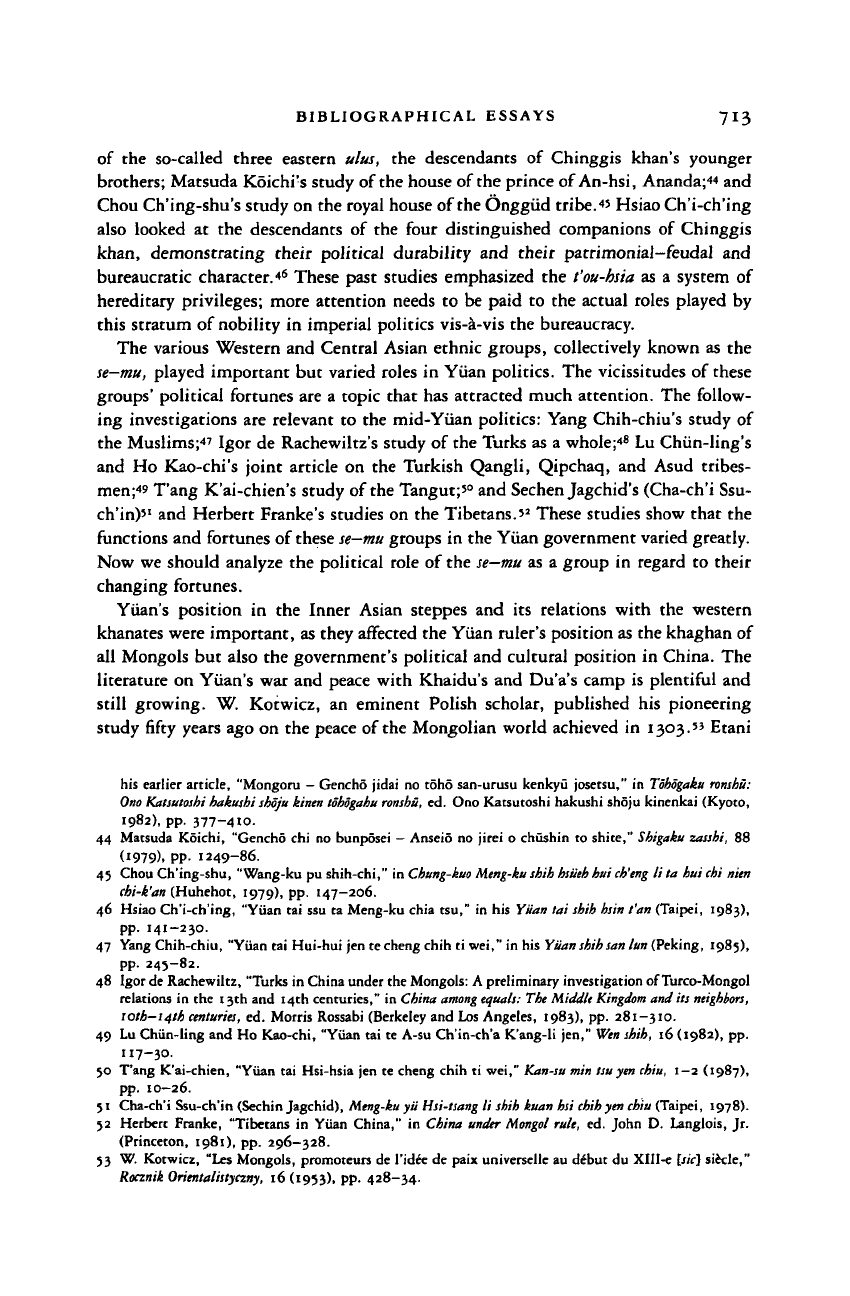
BIBLIOGRAPHICAL ESSAYS 713
of the so-called three eastern ulus, the descendants of Chinggis khan's younger
brothers;
Matsuda Koichi's study of the house of the prince of
An-hsi,
Ananda;
44
and
Chou Ch'ing-shu's study on the royal house of the Onggiid tribe.
45
Hsiao Ch'i-ch'ing
also looked at the descendants of the four distinguished companions of Chinggis
khan, demonstrating their political durability and their patrimonial-feudal and
bureaucratic character.
46
These past studies emphasized the
t'ou-hsia
as a system of
hereditary privileges; more attention needs to be paid to the actual roles played by
this stratum of nobility in imperial politics vis-a-vis the bureaucracy.
The various Western and Central Asian ethnic groups, collectively known as the
se-mu,
played important but varied roles in Yuan politics. The vicissitudes of these
groups'
political fortunes are a topic that has attracted much attention. The follow-
ing investigations are relevant to the mid-Yuan politics: Yang Chih-chiu's study of
the Muslims;
47
Igor de Rachewiltz's study of the Turks as a whole;
48
Lu Chun-ling's
and Ho Kao-chi's joint article on the Turkish Qangli, Qipchaq, and Asud tribes-
men;
4
' T'ang K'ai-chien's study of the Tangut;
50
and Sechen Jagchid's (Cha-ch'i Ssu-
ch'in)'
1
and Herbert Franke's studies on the Tibetans.'
2
These studies show that the
functions and fortunes of these se—mu groups in the Yuan government varied greatly.
Now we should analyze the political role of the se—mu as a group in regard to their
changing fortunes.
Yiian's position in the Inner Asian steppes and its relations with the western
khanates were important, as they affected the Yuan ruler's position as the khaghan of
all Mongols but also the government's political and cultural position in China. The
literature on Yiian's war and peace with Khaidu's and Du'a's camp is plentiful and
still growing. W. Kotwicz, an eminent Polish scholar, published his pioneering
study fifty years ago on the peace of the Mongolian world achieved in
1303."
Etani
his earlier article, "Mongoru — Gencho jidai no toho san-urusu kenkyu josetsu," in
Tohogaku
ronshu:
One Katsuioshi
hakushi
shoju kitten
tohigahu
ronshu,
ed. Ono Katsutoshi hakushi shoju kinenkai (Kyoto,
1982), pp. 377-410.
44 Matsuda Koichi, "Gencho chi no bunposei - Anseio no jirei o chushin to shite," Sbigaku
zasshi,
88
('979). PP- 1249-86.
45 Chou Ch'ing-shu, "Wang-ku pu shih-chi," in
Chung-kuo Meng-ku
shih
hsiieh
hui
ch'eng
li ta hui
chi
nien
chi-k'an (Huhehot, 1979), pp. 147—206.
46 Hsiao Ch'i-ch'ing, "Yuan tai ssu ta Meng-ku chia tsu," in his Yiian tai shih hsin t'an (Taipei, 1983),
pp.
141-230.
47 Yang Chih-chiu, "Yiian tai Hui-hui jen te cheng chih ti wei," in his Yiian
shih san
lun (Peking, 1985),
pp.
245-82.
48 Igor de Rachewiltz, "Turks in China under the Mongols: A preliminary investigation of Turco-Mongol
relations in the 13th and 14th centuries," in China
among
equals:
The Middle
Kingdom
and its
neighbors,
10th—14th
centuries,
ed. Morris Rossabi (Berkeley and Los Angeles, 1983), pp. 281—310.
49 Lu Chun-ling and Ho Kao-chi, "Yiian tai te A-su Ch'in-ch'a
K'ang-li
jen,"
Wen
shih, 16 (1982), pp.
117-30.
50
T'ang
K'ai-chien, "Yiian tai Hsi-hsia jen te cheng chih ti wei," Kan-su min tsu yen
chiu,
1-2 (1987),
pp.
10—26.
51 Cha-ch'i Ssu-ch'in (Sechin Jagchid),
Meng-ku
yii Hsi-tsang li shih kuan hsi
chih yen chiu
(Taipei, 1978).
52 Herbert Franke, "Tibetans in Yiian China," in China under Mongol rule, ed. John D. Langlois, Jr.
(Princeton, 1981), pp. 296—328.
53 W. Kotwicz, "Les Mongols, promoteurs de
l'idee
de paix universelle au d£but du XIII-c [sic] siecle,"
Rocznik
Orientalistyczny, 16 (1953), pp. 428-34.
Cambridge Histories Online © Cambridge University Press, 2008

714 BIBLIOGRAPHICAL ESSAYS
Toshiyuki,
a
Japanese scholar, wrote an article on Khaidu's war with the Yuan.'4 Liu
Ying-shen is currently the most active researcher on the Yuan's relations with the
Central Asian khanates and has written several articles on the subject, comparing the
Chinese and the Persian sources." The lengthy articles by Saguchi Toru, the senior
Japanese Mongolist, on the 1303 peace and on later Yuan relations with the western
khanates, published in 1942, still are useful in regard to the Yuan's post-1303
relations with the western khanates.'
6
Thomas Allsen documented the struggle
between the Yuan and the Ogodei and Chaghadai khanates for the control of
Uighuristan." In addition to his study of the changing Yuan relations with the
steppe, in his
Conquerors
and
Confucians,
Dardess wrote an interesting and well-
researched article on the limitations of the Yuan's efforts to control Mongolia and
Central Asia from distant China, attributing the loss of Central Asia in the late
1320s to what he calls "spatial limitations."'
8
The study of the political history of a period cannot entirely omit the political,
judicial, economic, and cultural institutions and policies of its government. The
new political institutions of the mid-Yuan, the Department of State Affairs (Shang-
shu sheng), which was established by Khaishan to increase the state's revenue, was
the subject of a monograph by the Japanese scholar Aoyama Koryo.'
9
The civil
service examination system restored by Ayurbawarda was investigated by Miyazaki
Ichisada,
60
Yang Shu-fan,
6
' Yao Ta-li,
62
and Ting K'un-chien.
6
' Hsiao Ch'i-ch'ing
studied the impact of the restoration of the civil service examinations on the elite's
mobility on the basis of the
chin-shih
of the 1333 class.
64
Concerning judicial
developments, Paul Ratchnevsky's
Un code des
Yuan
6
*
remains a rich mine that every
student of Yuan institutional history must explore. Paul H. C. Chen's monograph
Chinese legal tradition
under
the
Mongols,
66
though chiefly dealing with the code of
54 Etani Toshiyuki, "Kaido no ran ni kansuru no ichi kosatsu," in Tatnura hakmhi shoju Toyosbi
ronso
(Kyoto, 1968), pp. 89—104.
55 Liu Ying-sheng, "Shih-chi Wo-k'uo-t'ai han kuo mo nien chi shih pu cheng," Yiian shih cbipei fang
min tsu shih
yen
chiu chi k'an, 10 (1986), pp. 48-59; "Yiian-tai Meng-ku chu han kuo chien te yileh ho
chi Wo-k'uo-t'ai han kuo te mieh wang," Hsin-chiang la
hsiieh
biiiehpao, 2 (198;), pp. 31-43.
56 Saguchi Toru, "Jushi seiki ni okeru Gencho daiken to seihd san-oke to no rentaisei ni tsuite," Kita Ajia
gakuho, 1 (1942), pp. 151-214.
57 Thomas T. Allsen, "The Yiian dynasty and the Uighurs of Turfan in the 13th century," in China
among
equals: The Middle Kingdom and its
neighbors,
10th—
14th
centuries,
ed. Morris Rossabi (Berkeley and Los
Angeles, 1983), pp. 281—310.
58 John D. Dardess, "From Mongol empire to the Yiian dynasty: Changing forms of imperial rule in
Mongolia and Central Asia," Monumtnta
Serica,
30 (1972-3), pp. 117-65.
59 Aoyama Koryo,
Gencho shoshosho ko
(Tokyo, 1951).
60 Miyazaki Ichisada, "Gencho chika no Mokoteki kanshoku wo meguru Mo Kan kankei-kakyo fukko
no igi no saikento," Toyoshi
kenkyu,
23 (1965), pp. 428-91.
61 Yang Shu-fan, "Yiian-tai k'o-chiichih-tu," Kuo li
cheng chih
ta
hsiieh
hju'eh
pao,
17(1968),pp. 99—120.
62 Yao Ta-li, "Yuan tai k'o chii chih tu te hsing fei chi ch'i she hui pei ching," Yiian shih
chi
pei fang min
tsu shih yen chiu chi k'an, 6 (1982), pp. 26-59.
63 Ting K'un-chien, "Yiian tai te k'o chii chih tu," Hua
hsiieh yueh
k'an, 124 (1982), pp. 46-57.
64 Hsiao Ch'i-ch'ing, "Yuan tai k'o chu yii ching ying liu tung, I: Yuan-t'ung yiian nien chin shih wei
chung hsin," Han
hsiieh
yen chiu, 5 (1987), pp. 129-60.
65 Paul Ratchnevsky, Vn
code
des Yuan, 4 vols. (Paris, 1937-85).
66 Paul Heng-chao Ch'en, Chinese legal tradition under the Mongols: The code of 1291 as
reconstructed
(Princeton, 1979), pp. 108—9.
Cambridge Histories Online © Cambridge University Press, 2008
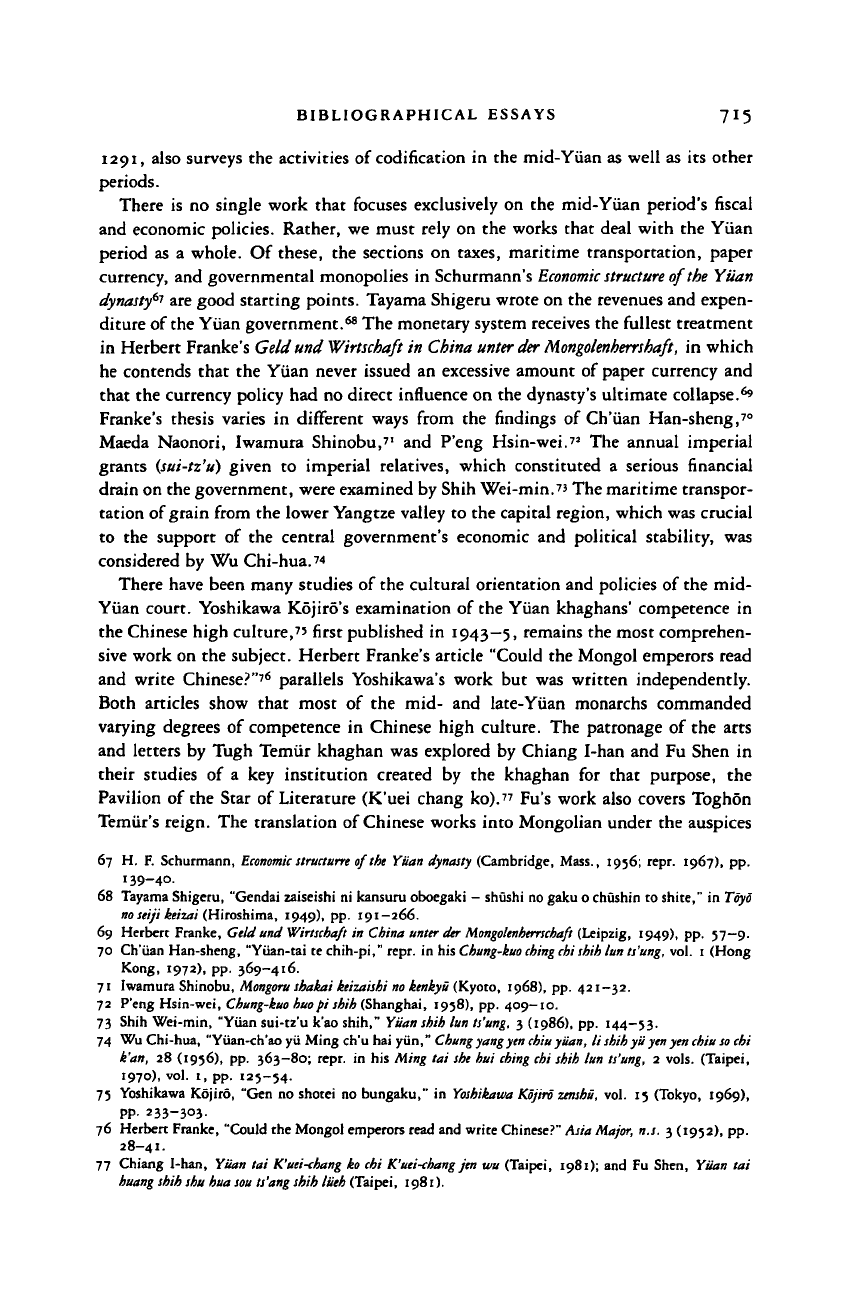
BIBLIOGRAPHICAL ESSAYS 715
1291,
also surveys the activities of codification in the mid-Yuan as well as its other
periods.
There is no single work that focuses exclusively on the mid-Yuan period's fiscal
and economic policies. Rather, we must rely on the works that deal with the Yuan
period as a whole. Of these, the sections on taxes, maritime transportation, paper
currency, and governmental monopolies in Schurmann's
Economic structure
of
the
Yuan
dynasty
61
are
good starting points. Tayama Shigeru wrote on the revenues and expen-
diture of the Yuan government.
68
The monetary system receives the fullest treatment
in Herbert Franke's Geld und Wirtschaft in China unter
der
Mongolenherrshaft,
in which
he contends that the Yuan never issued an excessive amount of paper currency and
that the currency policy had no direct influence on the dynasty's ultimate collapse.*»
Franke's thesis varies in different ways from the findings of Ch'iian Han-sheng,
7
°
Maeda Naonori, Iwamura Shinobu,
71
and P'eng Hsin-wei.
7J
The annual imperial
grants (sui-tz'u) given to imperial relatives, which constituted a serious financial
drain on the government, were examined by Shih Wei-min." The maritime transpor-
tation of grain from the lower Yangtze valley to the capital region, which was crucial
to the support of the central government's economic and political stability, was
considered by Wu Chi-hua.
7
<
There have been many studies of the cultural orientation and policies of the mid-
Yuan court. Yoshikawa Kojiro's examination of the Yuan khaghans' competence in
the Chinese high culture,
75
first published in 1943—5, remains the most comprehen-
sive work on the subject. Herbert Franke's article "Could the Mongol emperors read
and write Chinese?"
76
parallels Yoshikawa's work but was written independently.
Both articles show that most of the mid- and late-Yuan monarchs commanded
varying degrees of competence in Chinese high culture. The patronage of the arts
and letters by Tugh Temiir khaghan was explored by Chiang I-han and Fu Shen in
their studies of a key institution created by the khaghan for that purpose, the
Pavilion of the Star of Literature (K'uei chang ko).
77
Fu's work also covers Toghon
Temiir's reign. The translation of Chinese works into Mongolian under the auspices
67 H. F. Schurmann,
Economic
structum of
the
Yuan dynasty (Cambridge, Mass., 1956; repr. 1967), pp.
139-40.
68 Tayama Shigecu, "Gendai zaiseishi ni kansuru oboegaki - shushi no gaku o chushin co shite," in Toyo
no
seiji keizai (Hiroshima, 1949), pp. 191-266.
69 Herbert Franke, Geld und Wirtschaft in China unter der
Mongolenherrschaft
(Leipzig, 1949), pp. 57—9.
70 Ch'iian Han-sheng, "Yiian-tai te chih-pi," repr. in his
Chung-kuo ching
chishih lun
ts'ung,
vol. 1 (Hong
Kong, 1972), pp. 369-416.
71 Iwamura Shinobu,
Mongoru
shakai keizaishi
no
kenkyu (Kyoto, 1968), pp. 421-32.
72
P'eng
Hsin-wei,
Chung-kuo
huopi shih (Shanghai, 1958), pp. 409-10.
73 Shih Wei-min, "Yuan sui-tz'u k'ao shih," Yuan shih lun
ts'ung,
3 (1986), pp. 144-53.
74 Wu Chi-hua, "Yiian-ch'ao yii Ming ch'u hai yun,"
Chung
yang
yen chiu
yuan, li
shih
yil
yen yen chiu so
chi
fan, 28 (1956), pp. 363—80; repr. in his Ming tai she hui ching chi shih lun
ts'ung,
2 vols. (Taipei,
1970), vol. 1, pp. 125-54.
75 Yoshikawa Kojiro, "Gen no shotei no bungaku," in Yoshikawa Kojirg
zenshu,
vol. 15 (Tokyo, 1969),
PP- 233-3O3-
76 Herbert Franke, "Could the Mongol emperors read and write Chinese?" Asia
Major,
n.s. 3 (1952), pp.
28-41.
77 Chiang I-han, Yuan tai K'uei-fhang ko chi
K'uei-chang
jen wu (Taipei, 1981); and Fu Shen, Yuan tai
huang
shih shu hua
sou
ts'ang shih
lu'eh
(Taipei, 1981).
Cambridge Histories Online © Cambridge University Press, 2008
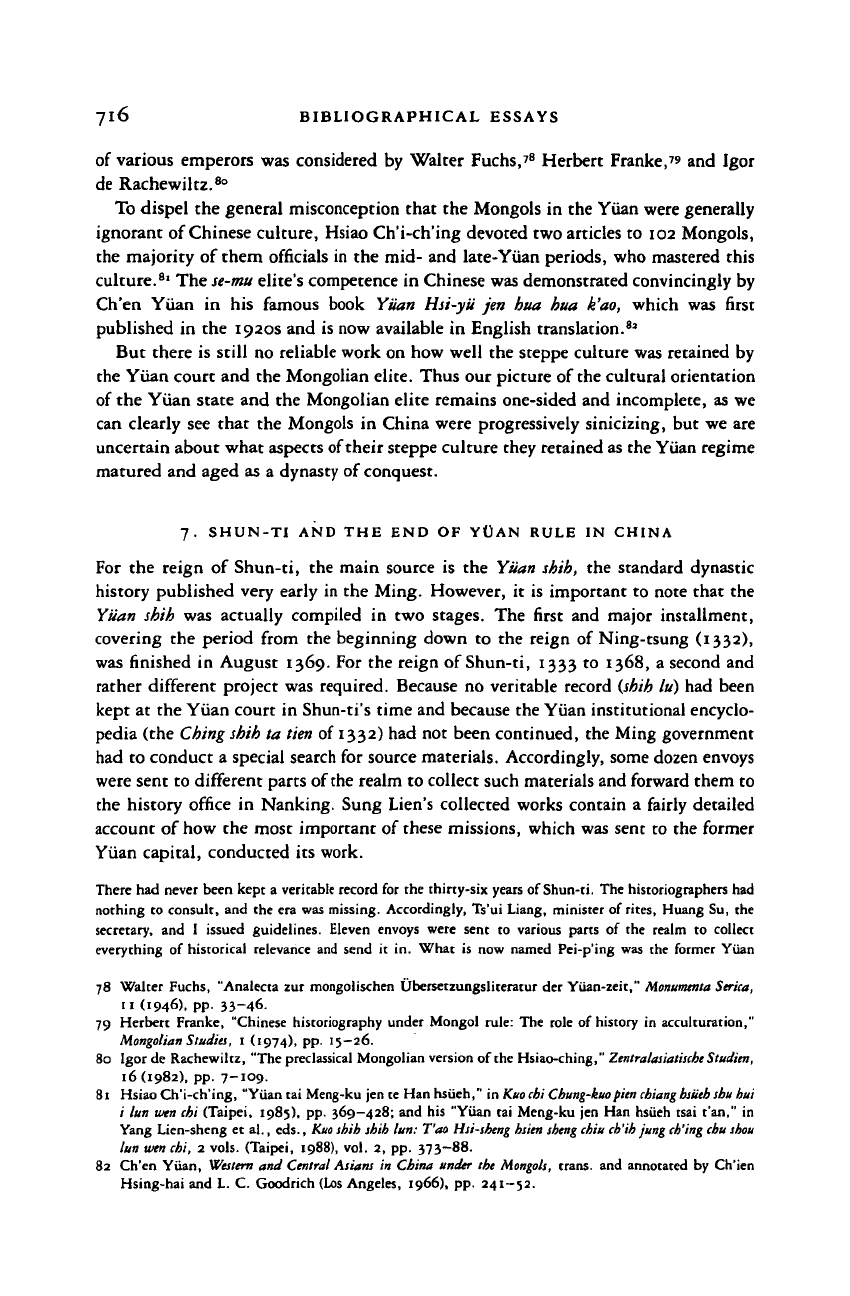
Jl6 BIBLIOGRAPHICAL ESSAYS
of various emperors was considered by Walter Fuchs,
78
Herbert Franke," and Igor
de Rachewiltz.
80
To dispel the general misconception that the Mongols in the Yuan were generally
ignorant of Chinese culture, Hsiao Ch'i-ch'ing devoted two articles to 102 Mongols,
the majority of them officials in the mid- and late-Yiian periods, who mastered this
culture.
8
' The
se-mu
elite's competence in Chinese was demonstrated convincingly by
Ch'en Yuan
in his
famous book Yiian Hsi-yii jen hua hua k'ao, which was first
published in the 1920s and is now available in English translation.
83
But there is still no reliable work on how well the steppe culture was retained by
the Yuan court and the Mongolian elite. Thus our picture of the cultural orientation
of the Yiian state and the Mongolian elite remains one-sided and incomplete, as we
can clearly see that the Mongols in China were progressively sinicizing, but we are
uncertain about what aspects of their steppe culture they retained as the Yiian regime
matured and aged as a dynasty of conquest.
7. SHUN-TI AND THE END OF YUAN RULE IN CHINA
For the reign
of
Shun-ti, the main source
is
the Yiian shih, the standard dynastic
history published very early in the Ming. However,
it
is important to note that the
Yiian sbih was actually compiled
in
two stages. The first and major installment,
covering the period from the beginning down
to
the reign of Ning-tsung (1332),
was finished in August 1369. For the reign of Shun-ti, 1333 to 1368, a second and
rather different project was required. Because no veritable record
(shih
lu) had been
kept at the Yiian court in Shun-ti's time and because the Yiian institutional encyclo-
pedia (the
Ching shih
ta
lien
of 1332) had not been continued, the Ming government
had to conduct a special search for source materials. Accordingly, some dozen envoys
were sent to different parts of the realm to collect such materials and forward them to
the history office
in
Nanking. Sung Lien's collected works contain
a
fairly detailed
account of how the most important of these missions, which was sent to the former
Yiian capital, conducted its work.
There had never been kept
a
veritable record for the thirty-six years of Shun-ti. The historiographers had
nothing
to
consult, and the era was missing. Accordingly, Ts'ui Liang, minister
of
rites, Huang Su,
the
secretary,
and I
issued guidelines. Eleven envoys were sent
to
various parts
of
the realm
to
collect
everything
of
historical relevance and send
it in.
What
is
now named Pei-p'ing was
the
former Yuan
78 Walter Fuchs, "Analecta zur mongolischen Ubersetzungsliteratur der Yiian-zeit," Monumtnta Serica,
11 (1946), pp. 33-46.
79 Herbert Franke, "Chinese historiography under Mongol rule: The role
of
history
in
acculturation,"
Mongolian Studies, 1 (1974), pp. 15—26.
80 Igor de Rachewiltz, "The preclassical Mongolian version of the Hsiao-ching," ZentralasiatischeSludien,
16(1982), pp. 7-109.
81 Hsiao Ch'i-ch'ing, "Yiian tai Meng-ku jen te Han hsiieh," in
Kuo
cbi Chung-kuopin
cbiang bsiieb sbu
hui
i lun wen chi (Taipei, 198;), pp. 369—428; and his "Yuan
tai
Meng-ku jen Han hsiieh tsai t'an,"
in
Yang Lien-sheng
et
al., eds.,
Kuo
shib shib lun: T'ao Hsi-sbeng
hsien sheng chiu cb'ib
jung
cb'ing
cbu
shou
lun wen chi,
2
vols.
(Taipei,
1988),
vol.
2,
pp.
373-88.
82 Ch'en Yuan,
Western
and Central Asians
in
China under the Mongols, trans, and annotated
by
Ch'ien
Hsing-hai
and L.
C.
Goodrich
(Los
Angeles,
1966),
pp.
241-52.
Cambridge Histories Online © Cambridge University Press, 2008
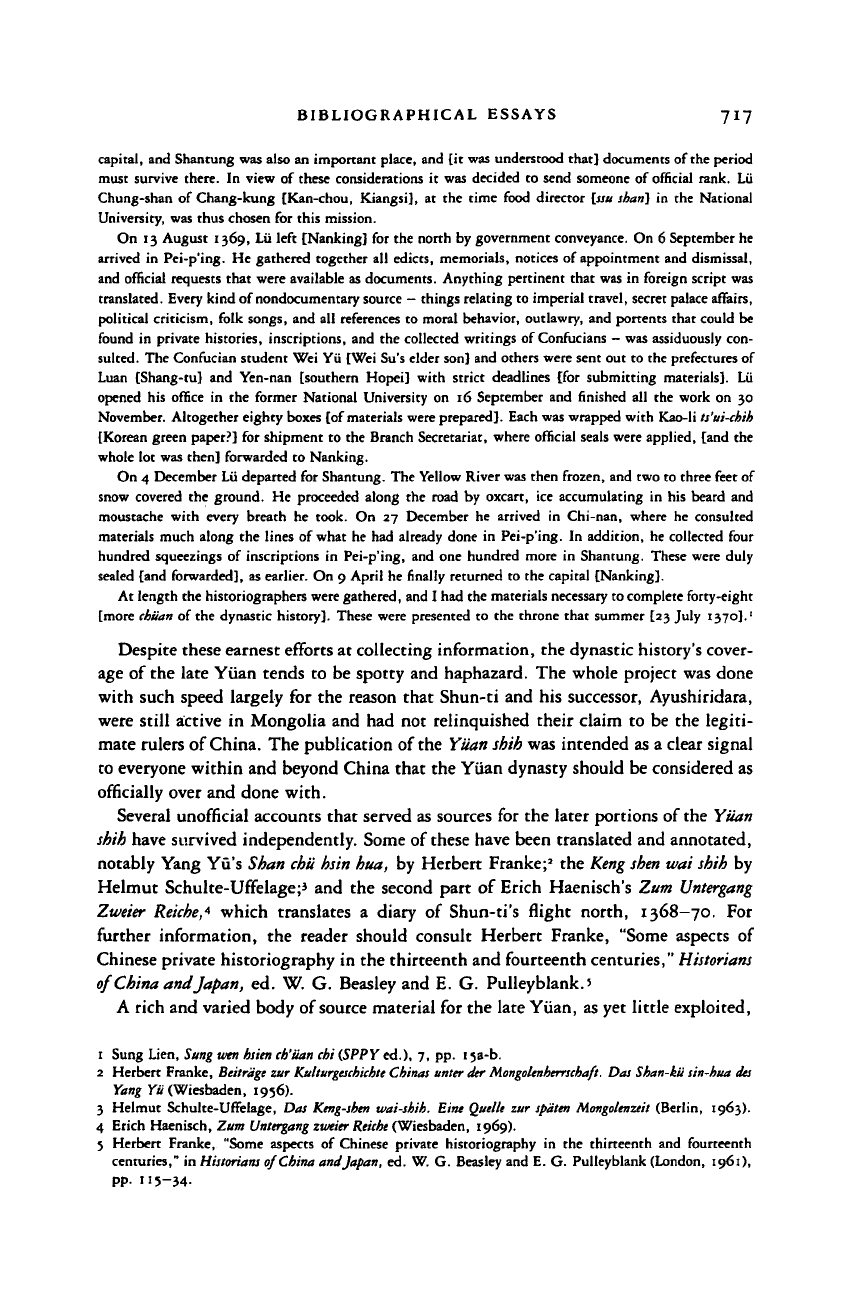
BIBLIOGRAPHICAL ESSAYS 717
capital, and Shantung was also an important place, and {it was understood that] documents of the period
must survive there. In view of these considerations it was decided to send someone of official rank. Lii
Chung-shan of Chang-kung [Kan-chou, Kiangsi), at the time food director [ssu shari] in the National
University, was thus chosen for this mission.
On 13 August 1369, Lii left [Nanking] for the north by government conveyance. On 6 September he
arrived in Pei-p'ing. He gathered together all edicts, memorials, notices of appointment and dismissal,
and official requests that were available as documents. Anything pertinent that was in foreign script was
translated. Every kind of nondocumentary source
—
things relating to imperial travel, secret palace affairs,
political criticism, folk songs, and all references to moral behavior, outlawry, and portents that could be
found in private histories, inscriptions, and the collected writings of Confucians
—
was assiduously con-
sulted. The Confucian student Wei Yii [Wei Su's elder son] and others were sent out to the prefectures of
Luan [Shang-tu] and Yen-nan [southern Hopei] with strict deadlines [for submitting materials]. Lii
opened his office in the former National University on 16 September and finished all the work on 30
November. Altogether eighty boxes [of materials were prepared]. Each was wrapped with Kao-li ts'ui-chih
[Korean green paper?] for shipment to the Branch Secretariat, where official seals were applied, [and the
whole lot was then] forwarded to Nanking.
On 4 December Lii departed for Shantung. The Yellow River was then frozen, and two to three feet of
snow covered the ground. He proceeded along the road by oxcart, ice accumulating in his beard and
moustache with every breath he took. On 27 December he arrived in Chi-nan, where he consulted
materials much along the lines of what he had already done in Pei-p'ing. In addition, he collected four
hundred squeezings of inscriptions in Pei-p'ing, and one hundred more in Shantung. These were duly
sealed [and forwarded], as earlier. On 9 April he finally returned to the capital [Nanking].
At length the historiographers were gathered, and I had the materials necessary to complete forty-eight
[more chiian of the dynastic history}. These were presented to the throne that summer [23 July
1370].'
Despite these earnest efforts at collecting information, the dynastic history's cover-
age of the late Yiian tends to be spotty and haphazard. The whole project was done
with such speed largely for the reason that Shun-ti and his successor, Ayushiridara,
were still active in Mongolia and had not relinquished their claim to be the legiti-
mate rulers of
China.
The publication of the
Yiian shih
was intended as a clear signal
to everyone within and beyond China that the Yiian dynasty should be considered as
officially over and done with.
Several unofficial accounts that served as sources for the later portions of the Yiian
shih
have survived independently. Some of these have been translated and annotated,
notably Yang Yu's
Shan chii hsin
hua,
by Herbert Franke;
2
the
Keng shen wai shih
by
Helmut Schulte-UffelagejJ and the second part of Erich Haenisch's Zum
Untergang
Zu/eier
Reiche,*
which translates a diary of Shun-ti's flight north, 1368-70. For
further information, the reader should consult Herbert Franke, "Some aspects of
Chinese private historiography in the thirteenth and fourteenth centuries,"
Historians
of
China
and Japan, ed. W. G. Beasley and E. G. Pulleyblank.'
A rich and varied body of
source
material for the late Yiian, as yet little exploited,
1 Sung Lien, Sung wen
hsien
cb'iian chi (SPPY ed.), 7, pp. 158-b.
2 Herbert Franke, Beitrdge zur
Kulturgeschichte
Chinas unter dtr
Mongolenhcrrschaft.
Das Shan-kii sin-hua del
Yang Yii (Wiesbaden, 1956).
3 Helmut Schulte-Uffelage, Das Keng-sbm wai-shih. Eine Quellt zur
spa'ten Mongolenzeit
(Berlin, 1963).
4 Erich Haenisch, Zum
Untergang
zwtier
Reicht
(Wiesbaden, 1969).
5 Herbert Franke, "Some aspects of Chinese private historiography in the thirteenth and fourteenth
centuries," in Historians of China and Japan, ed. W. G. Beasley and E. G. Pulleyblank (London, 1961),
pp.
115-34.
Cambridge Histories Online © Cambridge University Press, 2008
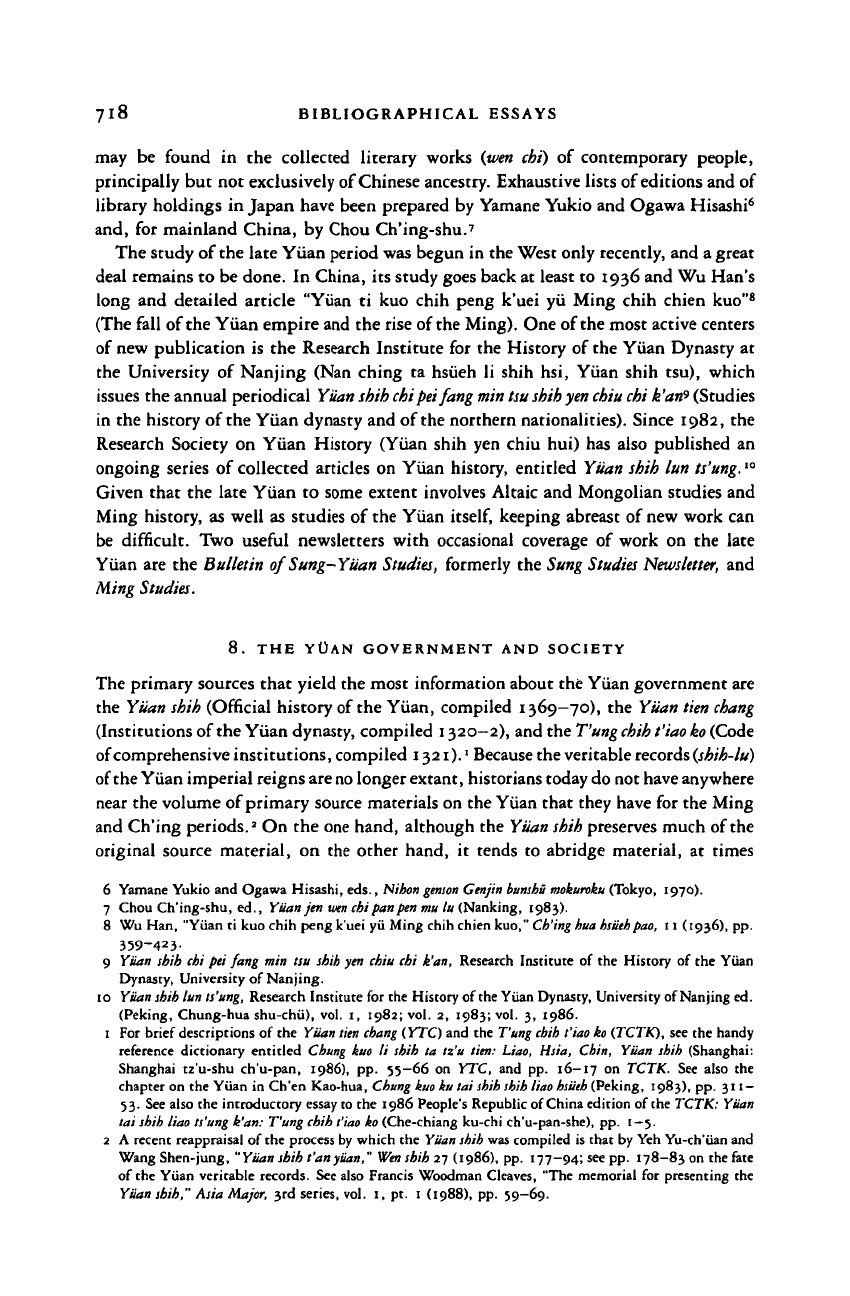
718 BIBLIOGRAPHICAL ESSAYS
may be found in the collected literary works
(wen
chi) of contemporary people,
principally but not exclusively of Chinese ancestry. Exhaustive lists of editions and of
library holdings in Japan have been prepared by Yamane Yukio and Ogawa Hisashi
6
and, for mainland China, by Chou Ch'ing-shu.
7
The study of
the
late Yiian period was begun in the West only recently, and
a
great
deal remains to be done. In China, its study goes back at least to 1936 and Wu Han's
long and detailed article "Yiian ti kuo chih peng k'uei yii Ming chih chien kuo"
8
(The fall of
the
Yiian empire and the rise of the Ming). One of
the
most active centers
of new publication is the Research Institute for the History of the Yiian Dynasty at
the University of Nanjing (Nan ching ta hsiieh li shih hsi, Yiian shih tsu), which
issues the annual periodical
Yiian shih
chi pet fang
tnin tsu shih yen chiu chi
k'an
9
(Studies
in the history of the Yiian dynasty and of the northern nationalities). Since 1982, the
Research Society on Yiian History (Yiian shih yen chiu hui) has also published an
ongoing series of collected articles on Yiian history, entitled
Yiian shih
lun ts'ung.
I0
Given that the late Yiian to some extent involves Altaic and Mongolian studies and
Ming history, as well as studies of the Yiian
itself,
keeping abreast of new work can
be difficult. Two useful newsletters with occasional coverage of work on the late
Yiian are the Bulletin of Sung-Yiian
Studies,
formerly the
Sung Studies
Newsletter,
and
Ming
Studies.
8. THE YOAN GOVERNMENT AND SOCIETY
The primary sources that yield the most information about the Yiian government are
the
Yiian shih
(Official history of the Yiian, compiled 1369-70), the
Yiian tien chang
(Institutions of the Yiian dynasty, compiled 1320-2), and the Tung
chih
t'iao
ko
(Code
of comprehensive institutions, compiled 1321).' Because the veritable records
(shih-lu)
of
the Yiian
imperial reigns
are no
longer extant, historians today do not have anywhere
near the volume of primary source materials on the Yiian that they have for the Ming
and Ch'ing periods.
2
On the one hand, although the
Yiian shih
preserves much of the
original source material, on the other hand, it tends to abridge material, at times
6 Yamane Yukio and Ogawa Hisashi, eds., Nihon
genson
Genjin bunsbi
mokuroku
(Tokyo, 1970).
7 Chou Ch'ing-shu, ed., Yiian jen
wen
chi pan
pen
mu lu (Nanking, 1983).
8 Wu Han, "Yiian ti kuo chih peng k'uei yii Ming chih chien kuo," Ch'ing hua
hsiiehpao,
11 (1936), pp.
359-423-
9 Yiian shih chi pei fang min tsu shih yen chiu chi k'an, Research Institute of the History of the Yiian
Dynasty, University of Nanjing.
10 Yiian shih lun ts'ung, Research Institute for the History of the Yiian Dynasty, University of Nanjing ed.
(Peking, Chung-hua shu-chu), vol. 1, 1982; vol. 1, 1983; vol. 3, 1986.
1 For brief descriptions of the Yiian tien chang (YTC) and the
T'ung
chih
t'iao ko (TCTK), see the handy
reference dictionary entitled Chung kuo li shih ta tz'u tien: Liao, Hsia, Chin, Yuan shih (Shanghai:
Shanghai tz'u-shu ch'u-pan, 1986), pp. 55—66 on YTC, and pp. 16—17 on
TCTK.
See also the
chapter on the Yiian in Ch'en Kao-hua, Chung kuo tu lai shih shih liao
hsiieh
(Peking, 1983), pp. 311—
53.
See also the introductory essay to the 1986 People's Republic of China edition of the
TCTK:
Yiian
tai shih liao ts'ung k'an:
T'ung
chih t'iao ko (Che-chiang ku-chi ch'u-pan-she), pp. 1—5.
2 A recent reappraisal of the process by which the Yiian shih was compiled is that by Yeh Yu-ch'uan and
Wang Shen-jung, "Yiian shih t'an
yiian,"
Wen
shih 27 (1986), pp. 177—94; see pp. 178—83 on the fete
of the Yiian veritable records. See also Francis Woodman Cleaves, "The memorial for presenting the
Yiian shih," Asia Major, 3rd series, vol. 1, pt. 1 (1988), pp. 59-69.
Cambridge Histories Online © Cambridge University Press, 2008
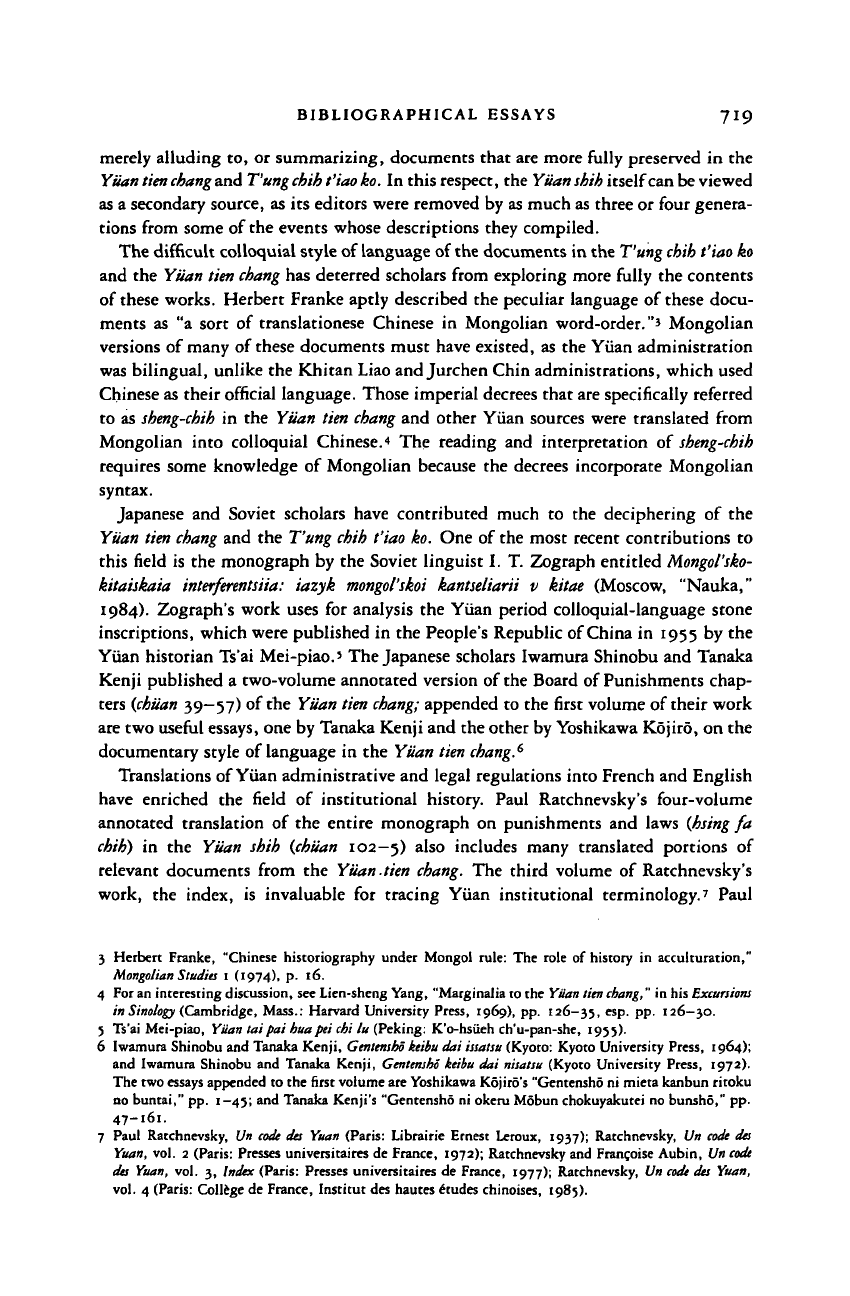
BIBLIOGRAPHICAL ESSAYS 719
merely alluding to, or summarizing, documents that are more fully preserved in the
Yiian tien chang and
T'ungchib
t'iao
ko.
In this respect, the
Yuan shib
itself
can be
viewed
as a secondary source, as its editors were removed by as much as three or four genera-
tions from some of the events whose descriptions they compiled.
The difficult colloquial style of language of
the
documents in the Tung
chih
t'iao
ko
and the
Yiian tien chang
has deterred scholars from exploring more fully the contents
of these works. Herbert Franke aptly described the peculiar language of these docu-
ments as "a sort of translationese Chinese in Mongolian word-order."
3
Mongolian
versions of many of these documents must have existed, as the Yiian administration
was bilingual, unlike the Khitan Liao and Jurchen Chin administrations, which used
Chinese as their official language. Those imperial decrees that are specifically referred
to as
sheng-chih
in the Yiian
lien chang
and other Yiian sources were translated from
Mongolian into colloquial Chinese.
4
The reading and interpretation of
sheng-chih
requires some knowledge of Mongolian because the decrees incorporate Mongolian
syntax.
Japanese and Soviet scholars have contributed much to the deciphering of the
Yiian tien chang
and the
T'ung
chih
t'iao
ko.
One of the most recent contributions to
this field is the monograph by the Soviet linguist I. T. Zograph entitled
Mongol'sko-
kitaiskaia interferentsiia: iazyk mongol'skoi kantseliarii v kitae (Moscow, "Nauka,"
1984).
Zograph's work uses for analysis the Yiian period colloquial-language stone
inscriptions, which were published in the People's Republic of China in 1955 by the
Yuan historian Ts'ai Mei-piao.' The Japanese scholars Iwamura Shinobu and Tanaka
Kenji published a two-volume annotated version of the Board of Punishments chap-
ters
{chiian
39—57) of the
Yiian tien
chang;
appended to the first volume of their work
are two useful
essays,
one by Tanaka Kenji and the other by Yoshikawa Kojiro, on the
documentary style of language in the
Yiian tien
chang.
6
Translations of Yiian administrative and legal regulations into French and English
have enriched the field of institutional history. Paul Ratchnevsky's four-volume
annotated translation of the entire monograph on punishments and laws
{hsing
fa
chih) in the Yiian shih
(chiian
102—5)
a
'
s0
includes many translated portions of
relevant documents from the Yiian.tien
chang.
The third volume of Ratchnevsky's
work, the index, is invaluable for tracing Yiian institutional terminology.' Paul
3 Herbert Franke, "Chinese historiography under Mongol rule: The role of history in acculturation,"
Mongolian
Studies 1 (1974), p. 16.
4 For an interesting discussion, see Lien-sheng Yang, "Marginalia to the Yiian
tien
chang,"
in his
Excursions
in
Sinology
(Cambridge, Mass.: Harvard University Press, 1969), pp. 126-35,
es
P' PP- 126—30.
5 Ts'ai Mei-piao, Yiian tat pai huapei chi lu (Peking: K'o-hsiieh ch'u-pan-she, 1955).
6 Iwamura Shinobu and Tanaka Kenji,
Gentensho
ktibu dai issatsu (Kyoto: Kyoto University Press, 1964);
and Iwamura Shinobu and Tanaka Kenji,
Gentensho
keibu dai nisatsu (Kyoto University Press, 1972).
The two essays appended to the first volume are Yoshikawa Kojiro's "Gentensho ni mieta kanbun ritoku
no buntai," pp. 1—4;; and Tanaka Kenji's "Gentensho ni okeru Mdbun chokuyakutei no bunsho," pp.
47-161.
7 Paul Ratchnevsky, Vn
code
da Yuan (Paris: Librairie Ernest Leroux, 1937); Rarchnevsky, Un
code
des
Yuan, vol. 2 (Paris: Presses universitaires de France, 1972); Ratchnevsky and Franchise Aubin, Un
code
des Yuan, vol. 3, Index (Paris: Presses universitaires de France, 1977); Ratchnevsky, Un
code
des Yuan,
vol. 4 (Paris: College de France, Institut des hautes Itudes chinoises, 198;).
Cambridge Histories Online © Cambridge University Press, 2008
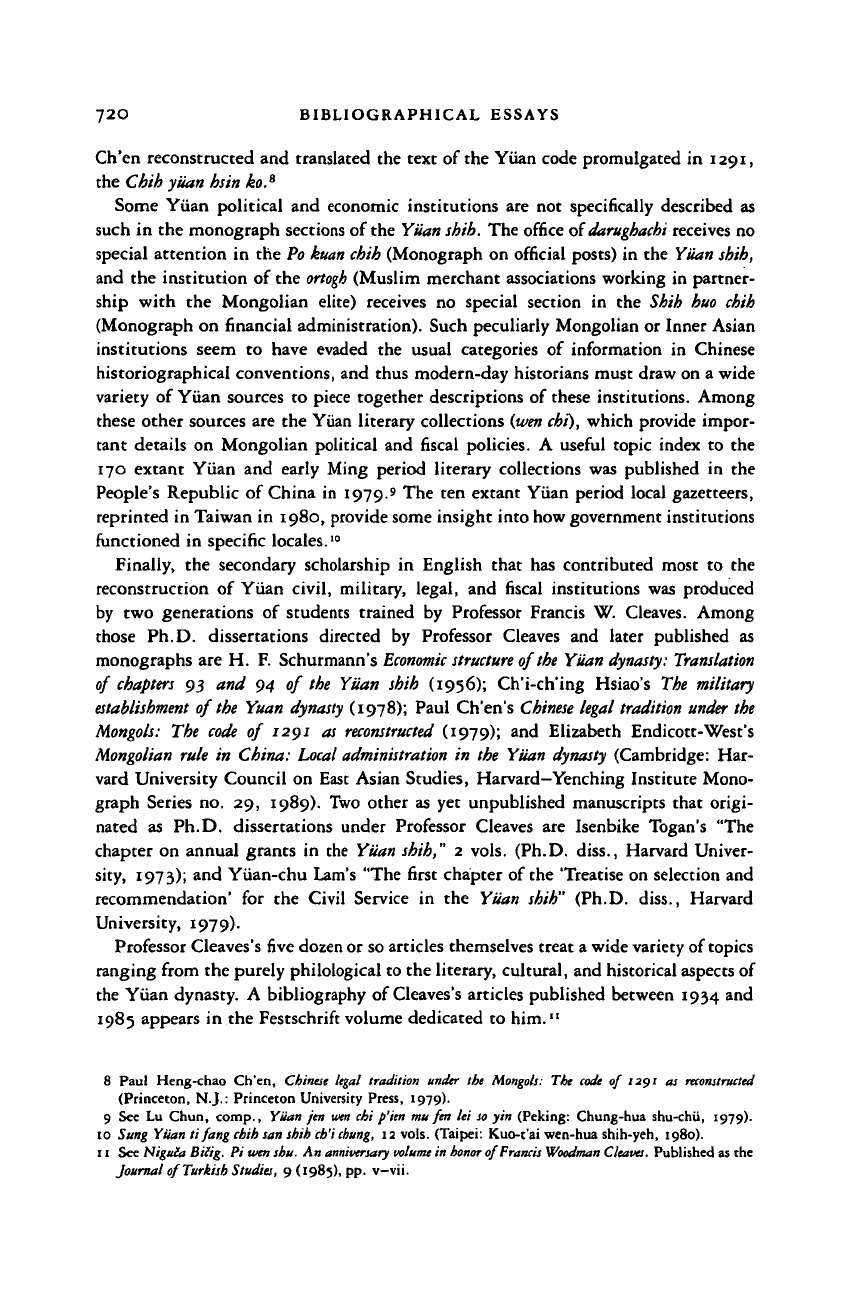
72O BIBLIOGRAPHICAL ESSAYS
Ch'en reconstructed and translated the text of the Yiian code promulgated in 1291,
the Chih
yiian hsin
ko.
8
Some Yiian political and economic institutions are not specifically described as
such in the monograph sections of the
Yiian
shih.
The office of
darughachi
receives no
special attention in the
Po
kuan chih
(Monograph on official posts) in the
Yiian
shih,
and the institution of the
ortogh
(Muslim merchant associations working in partner-
ship with the Mongolian elite) receives no special section in the Shih huo chih
(Monograph on financial administration). Such peculiarly Mongolian or Inner Asian
institutions seem to have evaded the usual categories of information in Chinese
historiographical conventions, and thus modern-day historians must draw on a wide
variety of Yiian sources to piece together descriptions of these institutions. Among
these other sources are the Yuan literary collections
(wen chi),
which provide impor-
tant details on Mongolian political and fiscal policies. A useful topic index to the
170 extant Yiian and early Ming period literary collections was published in the
People's Republic of China in 1979.' The ten extant Yiian period local gazetteers,
reprinted in Taiwan in 1980, provide some insight into how government institutions
functioned in specific locales.
10
Finally, the secondary scholarship in English that has contributed most to the
reconstruction of Yiian civil, military, legal, and fiscal institutions was produced
by two generations of students trained by Professor Francis W. Cleaves. Among
those Ph.D. dissertations directed by Professor Cleaves and later published as
monographs are H. F. Schurmann's
Economic structure
of the
Yiian
dynasty:
Translation
of
chapters
93 and 94 of
the
Yiian shih (1956); Ch'i-ch'ing Hsiao's The military
establishment
of
the
Yuan
dynasty
(1978); Paul Ch'en's
Chinese legal tradition under
the
Mongols:
The
code
of 1291 as
reconstructed
(1979); and Elizabeth Endicott-West's
Mongolian
rule in China:
Local administration
in the Yiian
dynasty
(Cambridge: Har-
vard University Council on East Asian Studies, Harvard—Yenching Institute Mono-
graph Series no. 29, 1989). Two other as yet unpublished manuscripts that origi-
nated as Ph.D. dissertations under Professor Cleaves are Isenbike Togan's "The
chapter on annual grants in the Yiian shih," 2 vols. (Ph.D. diss., Harvard Univer-
sity, 1973); and Yiian-chu Lam's "The first chapter of the "Treatise on selection and
recommendation' for the Civil Service in the Yiian shih" (Ph.D. diss., Harvard
University, 1979).
Professor Cleaves's five dozen or so articles themselves treat a wide variety of topics
ranging from the purely philological to the literary, cultural, and historical aspects of
the Yiian dynasty. A bibliography of Cleaves's articles published between 1934 and
1985 appears in the Festschrift volume dedicated to him."
8
Paul Heng-chao
Ch'en,
Chinese legal tradition under
the
Mongols:
The
code
of 1291 as
reconstructed
(Princeton, NJ.: Princeton University Press, 1979).
9 See Lu Chun, comp.,
Yiian
jtn
wen
chi
p'irn
mu
fen lei
so
yin (Peking: Chung-hua shu-chii, 1979).
10 Sung Yiian ti fang
chih
tan
shih
ch'ichung,
12 vols. (Taipei: Kuo-t'ai wen-hua shih-yeh, 1980).
11
See
Nigula
Bilig.
Pi
wen shu.
An
anniversary volume
in
honor
of
Francis Woodman
Cleaves.
Published
as
the
Journal
of
Turkish
Studies,
9
(1985),
pp. v—vii.
Cambridge Histories Online © Cambridge University Press, 2008
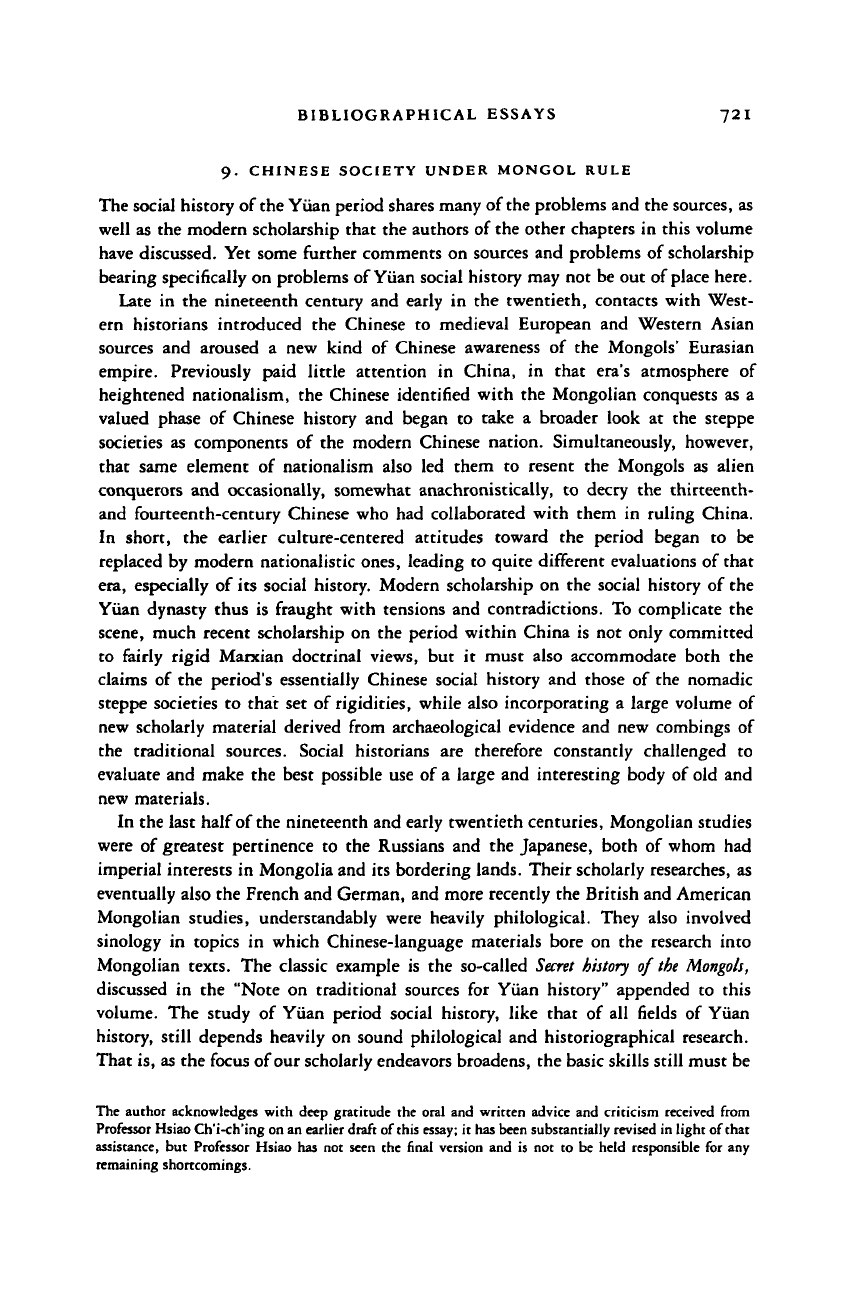
BIBLIOGRAPHICAL ESSAYS 721
9. CHINESE SOCIETY UNDER MONGOL RULE
The social history of
the
Yuan period shares many of
the
problems and the sources, as
well as the modern scholarship that the authors of the other chapters in this volume
have discussed. Yet some further comments on sources and problems of scholarship
bearing specifically on problems of
Yuan
social history may not be out of
place
here.
Late in the nineteenth century and early in the twentieth, contacts with West-
ern historians introduced the Chinese to medieval European and Western Asian
sources and aroused a new kind of Chinese awareness of the Mongols' Eurasian
empire. Previously paid little attention in China, in that era's atmosphere of
heightened nationalism, the Chinese identified with the Mongolian conquests as a
valued phase of Chinese history and began to take a broader look at the steppe
societies as components of the modern Chinese nation. Simultaneously, however,
that same element of nationalism also led them to resent the Mongols as alien
conquerors and occasionally, somewhat anachronistically, to decry the thirteenth-
and fourteenth-century Chinese who had collaborated with them in ruling China.
In short, the earlier culture-centered attitudes toward the period began to be
replaced by modern nationalistic ones, leading to quite different evaluations of that
era, especially of its social history. Modern scholarship on the social history of the
Yuan dynasty thus is fraught with tensions and contradictions. To complicate the
scene, much recent scholarship on the period within China is not only committed
to fairly rigid Marxian doctrinal views, but it must also accommodate both the
claims of the period's essentially Chinese social history and those of the nomadic
steppe societies to that set of rigidities, while also incorporating a large volume of
new scholarly material derived from archaeological evidence and new combings of
the traditional sources. Social historians are therefore constantly challenged to
evaluate and make the best possible use of a large and interesting body of old and
new materials.
In the last half of the nineteenth and early twentieth centuries, Mongolian studies
were of greatest pertinence to the Russians and the Japanese, both of whom had
imperial interests in Mongolia and its bordering lands. Their scholarly researches, as
eventually also the French and German, and more recently the British and American
Mongolian studies, understandably were heavily philological. They also involved
sinology in topics in which Chinese-language materials bore on the research into
Mongolian texts. The classic example is the so-called
Secret history
of
the
Mongols,
discussed in the "Note on traditional sources for Yuan history" appended to this
volume. The study of Yuan period social history, like that of all fields of Yuan
history, still depends heavily on sound philological and historiographical research.
That is, as the focus of our scholarly endeavors broadens, the basic skills still must be
The author acknowledges with deep gratitude the oral and written advice and criticism received from
Professor Hsiao Ch'i-ch'ing on an earlier draft of this essay; it has been substantially revised in light of that
assistance, but Professor Hsiao has not seen the final version and is not to be held responsible for any
remaining shortcomings.
Cambridge Histories Online © Cambridge University Press, 2008
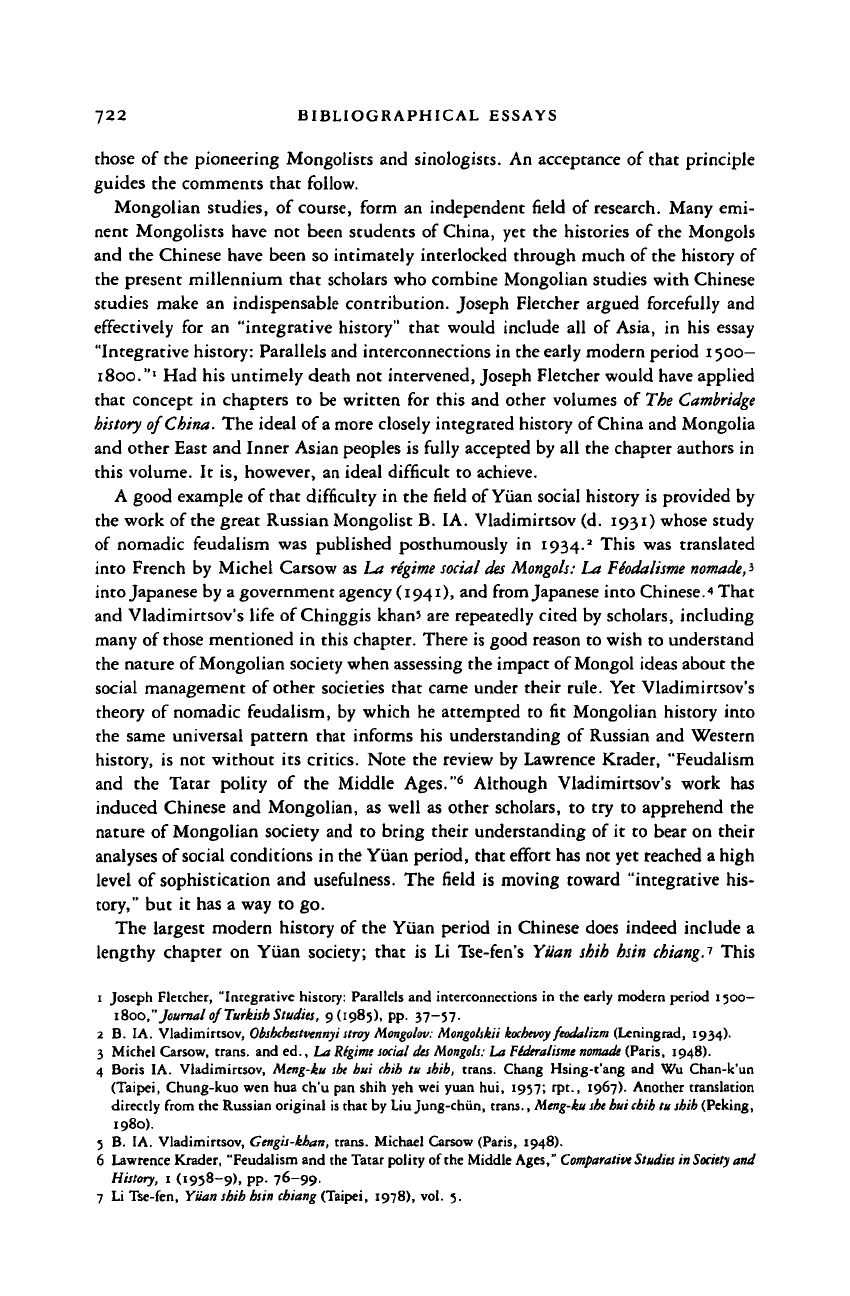
722 BIBLIOGRAPHICAL ESSAYS
those of the pioneering Mongolists and sinologists. An acceptance of that principle
guides the comments that follow.
Mongolian studies, of course, form an independent field of research. Many emi-
nent Mongolists have not been students of China, yet the histories of the Mongols
and the Chinese have been so intimately interlocked through much of the history of
the present millennium that scholars who combine Mongolian studies with Chinese
studies make an indispensable contribution. Joseph Fletcher argued forcefully and
effectively for an "integrative history" that would include all of Asia, in his essay
"Integrative history: Parallels and interconnections in the early modern period 1500-
1800."'
Had his untimely death not intervened, Joseph Fletcher would have applied
that concept in chapters to be written for this and other volumes of
The Cambridge
history
of China. The ideal of
a
more closely integrated history of China and Mongolia
and other East and Inner Asian peoples is fully accepted by all the chapter authors in
this volume. It is, however, an ideal difficult to achieve.
A good example of that difficulty in the field of
Yuan
social history is provided by
the work of the great Russian Mongolist B. IA. Vladimirtsov (d. 1931) whose study
of nomadic feudalism was published posthumously in 1934.
2
This was translated
into French by Michel Carsow as La
regime social des
Mongols:
La Fiodalisme nomade,
3
into
Japanese by a government agency (1941), and from Japanese into Chinese.'' That
and Vladimirtsov's life of Chinggis khan' are repeatedly cited by scholars, including
many of
those
mentioned in this chapter. There is good reason to wish to understand
the nature of Mongolian society when assessing the impact of
Mongol
ideas about the
social management of other societies that came under their rule. Yet Vladimirtsov's
theory of nomadic feudalism, by which he attempted to fit Mongolian history into
the same universal pattern that informs his understanding of Russian and Western
history, is not without its critics. Note the review by Lawrence Krader, "Feudalism
and the Tatar polity of the Middle Ages."
6
Although Vladimirtsov's work has
induced Chinese and Mongolian, as well as other scholars, to try to apprehend the
nature of Mongolian society and to bring their understanding of it to bear on their
analyses of social conditions in the Yuan period, that effort has not yet reached a high
level of sophistication and usefulness. The field is moving toward "integrative his-
tory," but it has a way to go.
The largest modern history of the Yuan period in Chinese does indeed include a
lengthy chapter on Yuan society; that is Li Tse-fen's Yuan shih hsin
chiang.
1
This
1 Joseph Fletcher, "Integrative history: Parallels and interconnections in the early modern period 1500—
i%oo," Journal of
Turkish
Studies, 9(1985), pp. 37-57.
2 B. IA. Vladimirtsov,
Obshchestveaayi
stray
Mongolov:
Mongolskii
kochevoy
feodalizm (Leningrad, 1934).
3 Michel Carsow, trans, and ed.. La
Rigime
social
des
Mongols:
La
Flderalisme nomade
(Paris, 1948).
4 Boris IA. Vladimirtsov, Meng-ku
she
hut chih tu sbib, trans. Chang Hsing-t'ang and Wu Chan-k'un
(Taipei, Chung-kuo wen hua ch'u pan shih yeh wei yuan hui, 1957; rpt., 1967). Another translation
directly from the Russian original is that by
Liu
Jung-chun, trans., Meng-ku
she
hui
chih
tu shih (Peking,
1980).
5 B. IA. Vladimirtsov, Gengis-kban, trans. Michael Carsow (Paris, 1948).
6 Lawrence Krader, "Feudalism and the Tatar polity of the Middle Ages,"
Comparative Studies
in
Society
and
History, I (1958-9), pp. 76-99.
7 Li Tse-fen, Yuan shih hsin chiang (Taipei, 1978), vol. 5.
Cambridge Histories Online © Cambridge University Press, 2008
